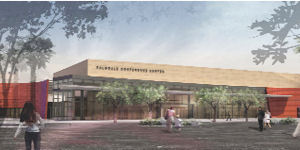The design has been completed and the process to obtain permits has started for what would be the premiere meeting space in the Antelope Valley. What the City of Palmdale now needs for its planned conference center is money to build it. And that may not be easy to come by. In different times the city’s redevelopment agency would have been able to fund the estimated $36 million facility slated to be constructed on seven acres on the southeast corner of Trade Center Drive and Avenue P-4. But in these dire times the California legislature decided that money held by the redevelopment agencies of Palmdale and other cities would be better spent plugging the state’s deficit. So Palmdale must wait until the conclusion of a lawsuit filed by the California Redevelopment Association challenging the state’s raid on redevelopment agency coffers. City officials hope the legal action will be resolved before its first payment of $11.5 million is due in May. “It is hard for us to do anything not knowing how it is going to land,” said Danny Roberts, the assistant executive director of Palmdale’s redevelopment agency. “We don’t want to make any large commitments.” The city has already waited a decade to get the conference center project moving. A study done 10 years ago concluded that such a center would be viable and recommended that it be located close to a hotel. The right site For all that time, however, there was no site that satisfied that requirement. All existing hotels had no adjacent land on which to build. Then Sun Development & Management Corp. entered the picture to build an upscale Embassy Suites hotel, which opened in February. Right next door the city purchased 7 acres for the convention center. By the end of March, the city expects to close on a smaller parcel to be used for parking. The design for the center ties the two buildings together, with the open space of the hotel flowing toward the meeting hall, said project manager Lynn Glidden. (Attempts to reach a representative of Sun Development were not successful.) The architect Gene Fong Associates incorporated into the design the look and feel of the area it is located. “We tried to make sure the flavor of the facility was consistent with the high desert,” Roberts said. Within its 77,000 square feet, the center includes an exhibition hall, an auditorium with seating for up to 200 people, six smaller meeting rooms ranging from 500 square feet to 1,055 square feet, and two smaller board rooms. Using certain building materials and sustainable practices in the construction and operation of the center allows for the city to apply for LEED certification from the U.S. Green Building Council. While the city will build and own the facility, an outside contractor will operate it for the exhibitions, conferences, and sporting and school events the city expects will take place there. With both Palmdale and Lancaster marketing themselves as a destination for business meetings and sports tourism the Antelope Valley has lagged in the physical space to host large scale events save for the fairgrounds. New center needed That exhibition space has its shortcomings and a new conference center would be welcome, said Josh Mann, executive director of the Antelope Valley Board of Trade. Each year the board hosts a business outlook conference at the fairgrounds that has drawn crowds of 500 to 1,200 people. “We have to bring in our own audio visual equipment,” Mann said. “As a professional meeting space there is no hotel immediate adjacent (to the fairgrounds).” With funding still up in the air, the city does what it can to get the project ready to move forward once the money is there. The Palmdale Planning Commission will consider the project as early as April and permit applications are being prepared for submittal to the Los Angeles County Health Department and the city’s building and safety department. All those measures are being taken to have the project permit ready for when funding becomes available. Other sources of money are under consideration, such as a federal grant and through naming rights. But it is still the redevelopment agency that will pick up much of the cost. “Once that (the lawsuit) is settled we can focus on raising money and our cash flow because we don’t have the state hanging over us,” Roberts said.
